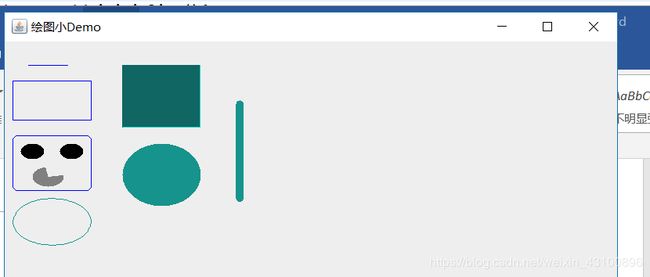Java绘图
绘图可以在应用程序中绘制图片、文字、图形等,在Java中主要可以使用Graphics和Graphics2D进行绘图,其中Graphics类是所有图形上下文的抽象基类,而Graphics2D就继承了Graphics类。而Graphics功能没有Graphics2D强大,Graphics2D是Graphics的扩展。
构造一个新的Graphics2D对象,因为Graphics2D是抽象类,所以无法直接创建对象,因很多绘图对象是Graphics类的实例,所以这里使用了强制转换。
public void paint(Graphics gp){
super.paint(gp);
Graphics2D gp2d = (Graphics2D) gp;
使用Graphics2D进行绘制图形
首先创建一个Demo1类继承JFrame类成为窗体,以便显示效果,在Demo1里创建一个内部类Plot类,该类继承JPanel类(容器,把图形放在这个容器里),
public class Demo1 extends JFrame{
private static final long serialVersionUID = 1L;
//创建绘图面板
class Plot extends JPanel{
private static final long serialVersionUID = 1L;
}
在Plot内部类重写panit()方法,再创建一个BasicStroke对象,Graphics2D可以调用setStroke方法设置笔画的属性,而这个方法要接受一个Stroke接口的实现类作为参数,这样可以通过不同的构造方法创建笔画属性的不同对象。
class Plot extends JPanel{
public void paint(Graphics gp){
//笔画属性,
BasicStroke bs = new BasicStroke( 10.1f,BasicStroke.CAP_ROUND,BasicStroke.JOIN_BEVEL);
super.paint(gp);
Graphics2D gp2d = (Graphics2D) gp;
}
}
在paint方法里面进行绘图,(设置绘图颜色后,后面绘图都是采取这颜色作为前景色,如果需要更改为其他颜色的话,可以再次调用setColor()方法进行再次设置)
class Plot extends JPanel{
private static final long serialVersionUID = 1L;
public void paint(Graphics gp){
//笔画属性,
BasicStroke bs = new BasicStroke( 10.1f,BasicStroke.CAP_ROUND,BasicStroke.JOIN_BEVEL);
super.paint(gp);
Graphics2D gp2d = (Graphics2D) gp;
gp2d.setColor(Color.blue);
//第一个点的x坐标,第一个点的y坐标,第二个点的x坐标,第二点的坐标
gp2d.drawLine(30, 30, 80, 30);
//绘制矩形的x坐标,绘制矩形的y坐标,矩形的宽度,矩形的高度
gp2d.drawRect(10,50,100,50);
//绘制矩形的x坐标,绘制矩形的y坐标,矩形的宽度,矩形的高度,4个角弧度的水平直径,4个角弧度的垂直直径
gp2d.drawRoundRect(10, 120, 100, 70, 12, 12);
gp2d.setColor(Color.black);
gp2d.fillOval(20, 130, 30, 20);
gp2d.fillOval(70, 130, 30, 20);
gp2d.setColor(Color.gray);
gp2d.fillArc(35, 160, 40, 25, 100, 270);
Color c1 = new Color(22, 147, 140);//创建红绿蓝不透明的srgb颜色
gp2d.setColor(c1);
gp2d.drawOval(10, 200, 100, 60);//绘制椭圆的边框。
//Graphics2D d=(Graphics2D) gp;
gp2d.fill3DRect(150, 30, 100, 80, false);
gp2d.fillOval(150,130, 100, 80);
gp2d.setStroke(bs);//设置笔画属性
gp2d.drawLine(300, 80, 300, 200);
}
}
在Demo类定义一个初始化窗体的方法,设置窗体大小,关闭窗体模式以及设置内容窗格等
//初始化窗体
private void initialize(){
this.setSize(800, 600);
setDefaultCloseOperation(JFrame.EXIT_ON_CLOSE);//设置窗体关闭模式
setContentPane(new Plot());
this.setTitle("绘图小Demo");
this.setLocationRelativeTo(null);//窗体居中
this.setVisible(true);//设置窗体的可见性
}
Demo类构造器 调用初始化方法
public Demo1(){
super();
initialize();
}
主方法 创建实例
public static void main(String[] args) {
new Demo1();
}
效果:
绘制图片:在图片上绘制字符串并输出成图片格式
public static void main(String[] args) throws FileNotFoundException, IOException {
// TODO Auto-generated method stub
//获取图片缓冲区
BufferedImage bi = new BufferedImage(80,40,BufferedImage.TYPE_INT_RGB);
//得到绘制坏境(这张图片的笔)
Graphics gh= (Graphics)bi.getGraphics();
gh.setColor(Color.WHITE);//设置颜色
gh.fillRect(0, 0, 80, 40);//填充整张图片(其实就是设置背景色)
gh.setColor(Color.lightGray);
//gh.drawRoundRect(0, 0, 130, 70, 130, 70);//绘制一个圆形边框
gh.drawRect(0, 0, 80-1, 40-1);//绘制一个四边形边框
gh.setFont(new Font("Bernard MT",Font.BOLD,18));//字体样式 字体格式 字体大小
gh.setColor(Color.BLUE);//设置字体颜色
gh.drawString(getNum(10,100), 22, 25);//向图片上写随机字符串
ImageIO.write(bi, "PNG", new FileOutputStream("D:/test.png"));//把图片输出到指定路径
随机生成字符串方法
public static String getNum(int num1,int num2){
//返回num1到num2之间的随机数
Integer rand = num1 + (int)(Math.random()*(num2-num1));
//System.out.println(rand);
int a = (int)(Math.random()*100);
//返回a~z随机的字符
char char1 = (char)('a'+Math.random()*('z'-'a'+1));
//返回A~Z随机的字符
char char2 = (char)('a'+Math.random()*('Z'-'A'));
return rand.toString()+char1+char2;
}
运行输出


